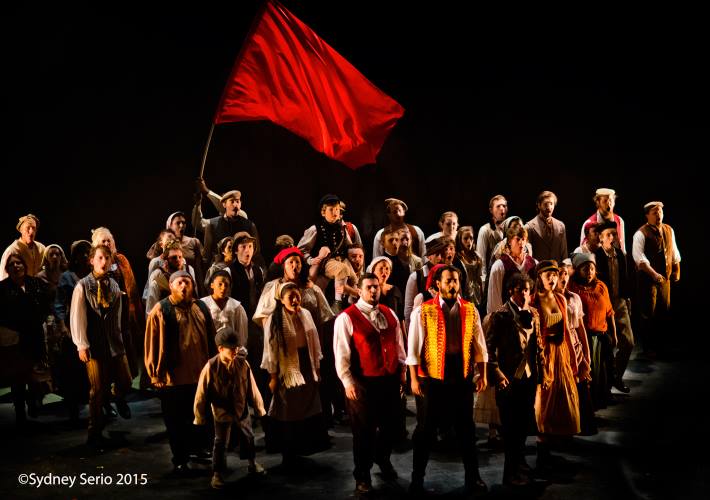At the end of the day it’s another show over. And that show it has surely been making its rounds. From Broadway to touring and finally released to the public— Les Miserables settles down for one show more at The Milburn Stone Theatre in North East Maryland. Broadway’s biggest musical is live in Cecil County for a three weekend limited engagement run and may be the last time that any area theatre is given the rights to perform the show for quite some time to come. Directed by Marji Eldreth, this particular production hints at previously un-played aspects of the show and brings a unique Milburn Stone twist to the show.
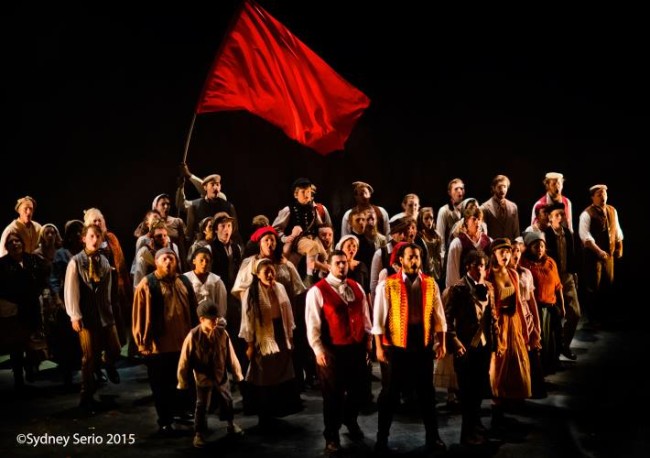
Scenic Designer Bob Denton leaves a lot of blank space upon the enormous stage giving Director Marji Eldreth a chance to squeeze in a lot of conceptualized internal-character wandering. Denton’s barricade is a unique structure that in its assembly looks like a stage coach wagon crashed into the middle of the streets of Paris. It’s cobbled together nature (including a slightly overbearingly symbolic coffin) speaks the truth of what a barricade would have looked like for the rebellious students trying to make a stand in the streets. Denton’s projections, those that can be seen, are striking, particularly the city backdrop with billowing smoke curls for “Little Fall of Rain” and the church yard featured in the initial encounter with the Bishop. Unfortunately the scrim is often bunched and distorts the projections so thoroughly that they can’t be seen in all their delicate beauty.
Praise and commendation aplenty for anyone that outfits a cast of more than 60 individuals and has them all looking as if they truly belong in the same show. Costume Designers Lance Bankerd and Ryan DeVoe gather the grit in the looks department and sprinkle it liberally across the rabble of the Parisian streets. The attention to particular detail— like Little Eponine’s (Gracie Milanoski) little blue hat or the French army uniform befitted to Valjean once he ascends the barricade is striking and really highlights the nuance of these characters. Bankerd and DeVoe’s true triumphs are particularly notable in the pristine look of Inspector Javert and the opposing bedraggled look of Thenardier. The drunken innkeeper’s costumes shift thrice throughout the performance, each look a perfect accessory to his wily and revolting personality.
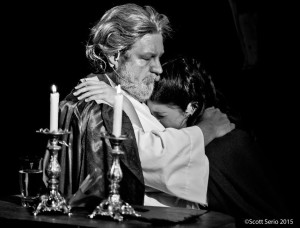
Director Marji Eldreth also serves as the show’s Musical Director, a noble effort to take on both tasks for a beast of a show like Les Miserables. Claude-Michel Shönberg’s music with Herbert Kretzmer’s lyrics are an epic challenge for any Musical Director, not to mention one that has to devote their attention to fully directing the show. Because of the split attention, the musical potential of the show is not fully actualized under Eldreth’s guidance. For a large ensemble there are songs, like “At the End of the Day” and “Master of the House” that lack both power and energy. But with that said, Eldreth does an exceptional job of finding the subtler harmonies featured in smaller group numbers like the students’ verses of “The People’s Song” and “Drink With Me.”
Eldreth attempts non-traditional casting by placing Ryan DeVoe in the role of Madam Thenardier. While the look is spectacular, a trussed up drag queen ready to eat everyone alive, the attitude and follow through of the character don’t match the image. DeVoe delivers a blasé sort of deadpan rather than the full-blown sassy and catty character that his image might intend and this creates a lot of missed opportunities throughout, particularly during “Master of the House.” DeVoe does have the single funniest line in the show, however, with an out of place ad-lib during “Beggars at the Feast” where he steals the attention of the audience, steals the grand master’s staff, and mumbles about a chicken.
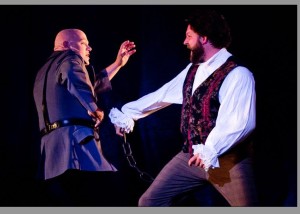
Eldreth’s directorial concepts are setting this production apart from other productions because of their originality and deviation from the show’s text in so much as legality from MTI will allow. The most controversial being the handling of Javert’s “Soliloquy” scene. Knowing the limitations of the theatre’s budget, Eldreth crafts a moment that fits the emotional swell of the scene, though it may not sit well with traditionalists, she gives it her best shot. The other striking concept, which if used only at the beginning and the end of the production would have made a much more profound impact, was the introduction of the silent characters Jean Valjean’s Sister (Dianna Collins) and her son (Judah Latshaw.) Featured in ghostly lighting (designed by William A. Price III) the fabrication of these characters into visible apparitions creates a heart-stirring moment; bookends to the perfect musical. Eldreth extinguishes the potency of this perfect concept that she has crafted, however, by having the woman and boy reappear constantly throughout the performance, heavily in the second act once the barricade has fallen. With a slighter hand to this notion, the execution of these characters could have been genius.
Eldreth does understand the nuance of blocking a scene. Hands down in the two years that the production has been running in community theatres, her blocking of “The Confrontation” is the cleanest and most flawlessly executed. The tension is palpable, the pacing is logical and the physical interaction of the actors (namely that they end up on the correct sides of Fantine’s death bed) is the epitome of what the scene is meant to look at feel like. The fight choreography in that scene is exceptionally tight making that moment one of the most vivid and believable in the production. Other well-conceived moments of textual understanding include her infusion of the women at the barricade and the aftermath of that experience during “Turning.” While there have always been women at the barricade, Eldreth’s choice to involve them vigorously in the activity therein results in a truly shocking rendition of “Turning” as the women of the barricade sit shell-shocked around their candles.
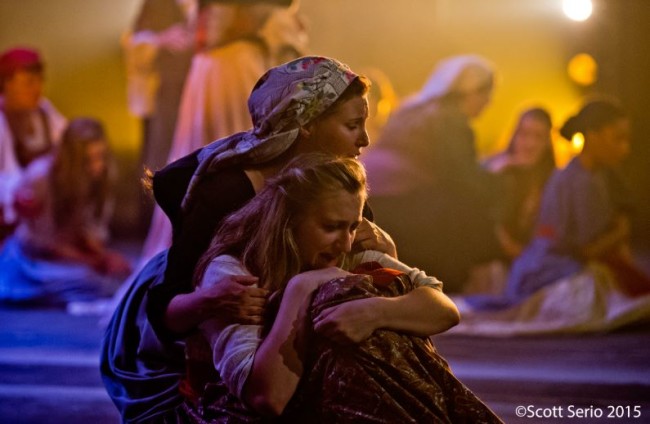
There a great many people that populate the ensemble but there are particularly individuals who deserve praise for their creative moments that really catch the attention of the audience. Joanna DiPaola, a girl at the barricade, becomes the most compelling thing to watch during the first firing scene among the students as she holds Inspector Javert at gunpoint while he tries to escape being bound to the chair. Her facial expressions and responses to the gunfire and chaos around her are priceless and captivating. Stefanie Jaye Griffin, who plays the Trinket Woman during “Lovely Ladies”, is gritty and uncouth, really making her character pop out of that scene.
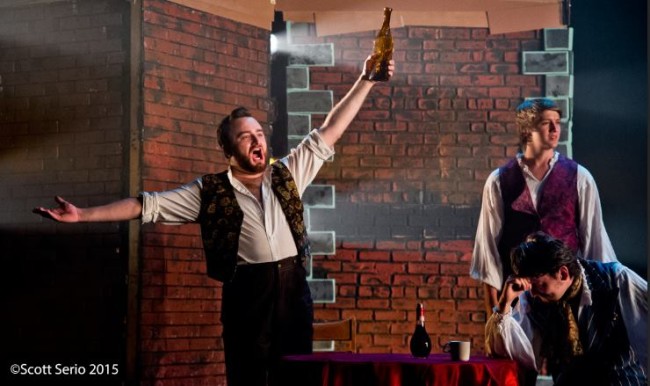
The boys of the barricade are plenty, Joly (Alex VanderLek) and Prouvaire (Neil Kirschling) making their voices heard at the top of “Drink With Me” before the song is taken over by Grantaire (Joseph Murphy.) At the top of the show during “Prologue” one might assume that it’s Murphy’s only chance to sing as he belts and rifts the opening lines to the chain gang portion of that number, but his sturdy voice peppers the production throughout once the students becomes an active part of the story. His mockery and interactions with Marius leading into “Red and Black” are congenial and he carries a strong stage presence, particularly when cowed by the death of Gavroche (Nathan Joseph.)
Enjolras (Daniel Urdaneta) leads Marius (Abu Akki) and the rest of the students to revolution. Urdaneta does have a strong voice, though it takes him quite some time to warm up to the fiery emotional intent that is required to make those songs work. It’s the lead into the second attack at the barricade where Urdaneta finds his internal flame and charges into the fray with conviction. Akki, who has a superb vocal quality for the gooey lovesick Marius character, plays nicely against Cosette (Christy Wyatt.) The pair alight with ardent amore for “A Heart Full of Love.”
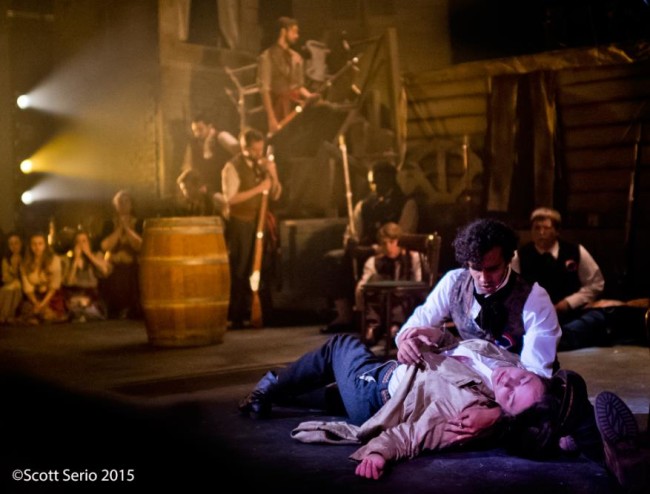
The grace and ease that fill Eponine’s (Charis Latshaw) character at first seem like they should belong to Cosette, but Latshaw’s interpretation of the street girl is that of fantasy; the life she wishes she had. Her rendition of “On My Own” is almost a recreation of Broadway’s original performance and is a fitting tribute to the traditional performance of the song. Latshaw wanders about the large empty stage, her wandering reconcilable with her drifting mind as her desperately unrequited love fills her voice and she emotionally connects hard with rejection in this number.
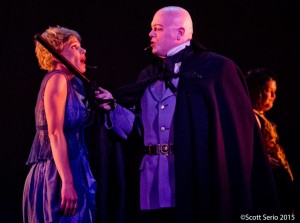
Rebekah Latshaw delivers a stunning rendition of “I Dreamed a Dream” as Fantine. The swells of sorrow that possess the imagery she paints in the number are overwhelming. Giving a dynamic race through the faces of Fantine— from desperate factory girl, to fallen woman, to dying angel— Latshaw delves into the character’s psyche and unearths those raw moments of vulnerability that tug at the heartstrings, like the street encounter with Valjean, which she does facing completely away from him.
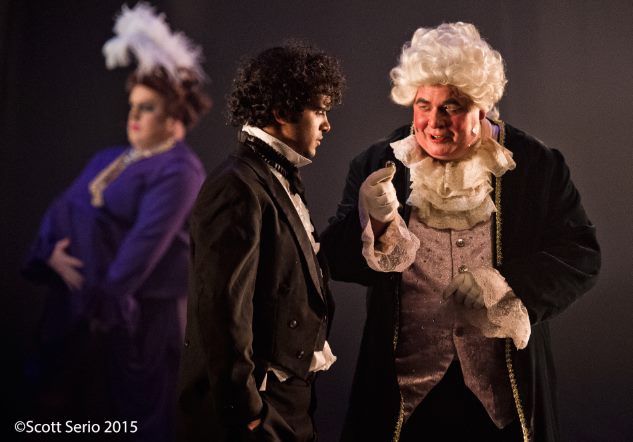
The second best performance given in the production falls to the lumpy shoulders of Master Thenardier (Scott Mason.) Mason thoroughly embodies the pisspot nature of Thenardier— drunkard extraordinaire— during “Master of the House.” Lumbering about he is the epitome of a vagrant vagabond that looks seedy; the sort that has a foul stench that precedes them into a room. But his soused nature is just one of the many faces of Thenardier, showcasing Mason’s versatility as an actor. By the time the street scene just prior to “Stars” arrives, and again during “Attack on Rue Plummet”, Mason has risen out of his drunken squalor and morphed into a lecherous disgusting villain, all the while keeping his voice like a churning pit of gravel. “Dog Eat Dog” easily sends shivers up the spine as his ruthless nature shines through in this number. Mason closes the performance with a series of silly airs during “Beggars at the Feast” and really tickles the fancy of the audience throughout the show.
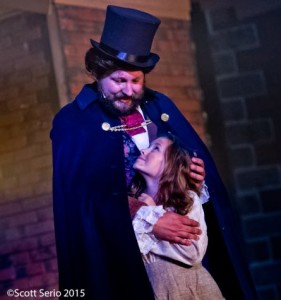
Lee Lewis undertakes the daunting task of bringing Jean Valjean to life. A very internalized portrayal, there are often moments when Lewis appears lost in his own mind but surprisingly this reads well for the character as it forces the audience to see how his decisions and justifications impact him continually as he progresses through his journey. Lewis’ voice is rather impressive, carrying the full range for the character, and holding his own against the rest of the cast all throughout. “The Confrontation” is a moment where Lewis’ voice shines with radiant strength; where both character and vocalist become one blazing entity and fuse together to create that sparking moment of fire. His rendition of “Bring Him Home” is touching, and the line where he looks directly at Marius and says “he is only a boy” is terribly intense, actualizing Valjean’s mission and putting his vulnerable cards down on the table.
True as the stars in the heavens Lance Bankerd gives a phenomenal performance as Inspector Javert. Fully invested, dedicated and unyielding in his piety and arrogance of the law, Bankerd is the epitome of what a Javert ought to be when storming across the stage. His facial features alone are enough to frighten and mesmerize the daylights out of anyone watching, but add to those wildly expressive faces an operatic voice that does in fact pierce the sky in the deepest of basement bass ranges and you have the perfect performance. His strangled moment during “The Confrontation” is authentic, and he imbues the character with emotional and vocal integrity for every moment that he is singing.
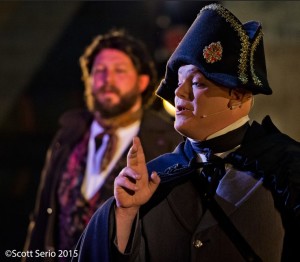
Bankerd’s voice simply melts into “Stars” and paints a celestial masterpiece of imagery with the number. Both this song and “Soliloquy” sit comfortably in his robust wheelhouse, Bankerd dominating both numbers into complete submission. The pivotal moment of his character portrayal comes as he enters “Soliloquy” where the emotional integrity of the change melds so perfectly into the vocal intention of the song that it is breathtaking. His mind unravels in the song and blows away; a remarkable sensation— Bankerd makes the show well worth the drive to the theatre and the cost of admission.
The last chance many will have for quite some time, conceptual issues aside, the production is solid and well worth investigating. There is truly exceptional talent contained within and a great many good things about this performance that make it well worth seeing.
Les Miserables plays through June 28, 2015 at The Milburn Stone Theatre— 1 Seahawk Drive in North East, MD. For tickets call the box office at 410-287-1037 or purchase them online.
Click here to read the interview with Lance Bankerd and Lee Lewis.

